-
Galeria Luisa Strina is pleased to present Unknown to the World, Tonico Lemos Auad’s fourth exhibition at the gallery. Bringing together textile works and sculptures made of reclaimed beams and railway sleepers, the show explores the relationship of these materials with architecture and landscape. The notion of ‘repair’ is central to Auad’s practice, both in terms of the methodologies employed in the making of the textile works (darning, tying, unthreading) and the choice of reclaimed wood as primary material for sculptures. Another important focus of interest in his work are the practices and techniques associated to different types of craft passed down through generations; many of which currently facing extinction in a global economy.
-







 Unknown to the world
Unknown to the worldAmongst the works presented is Unknown to the World – a sculpture that gives the title to the exhibition -, formed by four reclaimed beams with varied heights placed vertically on the floor. The pieces retain the worn-out marks accumulated during their previous life and in some of them the artist has placed pieces of linen in warm colours whose materiality contrasts with the solidity of the wood. Furthermore, the subtle carving performed by the artist on their surface gives the timber a simultaneously anthropomorphic and abstract appearance.
-
-
![Tonico Lemos Auad Arquitetura de sal, 2021 tecido feito à mão no tear, lã, linho [handwoven fabric, wool, linen] 126 x 150 x 2 cm 49 5/8 x 59 1/8 x 3/4 in](data:image/gif;base64,R0lGODlhAQABAIAAAAAAAP///yH5BAEAAAAALAAAAAABAAEAAAIBRAA7) Tonico Lemos AuadArquitetura de sal, 2021tecido feito à mão no tear, lã, linho
Tonico Lemos AuadArquitetura de sal, 2021tecido feito à mão no tear, lã, linho
[handwoven fabric, wool, linen]126 x 150 x 2 cm
49 5/8 x 59 1/8 x 3/4 in%3Cdiv%20class%3D%22artist%22%3ETonico%20Lemos%20Auad%3C/div%3E%3Cdiv%20class%3D%22title_and_year%22%3E%3Cspan%20class%3D%22title_and_year_title%22%3EArquitetura%20de%20sal%3C/span%3E%3Cspan%20class%3D%22comma%22%3E%2C%20%3C/span%3E%3Cspan%20class%3D%22title_and_year_year%22%3E2021%3C/span%3E%3C/div%3E%3Cdiv%20class%3D%22medium%22%3Etecido%20feito%20%C3%A0%20m%C3%A3o%20no%20tear%3Cspan%20class%3D%22comma%22%3E%2C%20%3C/span%3El%C3%A3%3Cspan%20class%3D%22comma%22%3E%2C%20%3C/span%3Elinho%3Cbr/%3E%0A%5Bhandwoven%20fabric%3Cspan%20class%3D%22comma%22%3E%2C%20%3C/span%3Ewool%3Cspan%20class%3D%22comma%22%3E%2C%20%3C/span%3Elinen%5D%3C/div%3E%3Cdiv%20class%3D%22dimensions%22%3E126%20x%20150%20x%202%20cm%3Cbr/%3E%0A49%205/8%20x%2059%201/8%20x%203/4%20in%3C/div%3E -
![Tonico Lemos Auad Carimbó, 2021 tecido feito à mão no tear, lã, linho [handwoven fabric, wool, linen] 82 x 100 x 2 cm 32 1/4 x 39 3/8 x 3/4 in](data:image/gif;base64,R0lGODlhAQABAIAAAAAAAP///yH5BAEAAAAALAAAAAABAAEAAAIBRAA7) Tonico Lemos AuadCarimbó, 2021tecido feito à mão no tear, lã, linho
Tonico Lemos AuadCarimbó, 2021tecido feito à mão no tear, lã, linho
[handwoven fabric, wool, linen]82 x 100 x 2 cm
32 1/4 x 39 3/8 x 3/4 in%3Cdiv%20class%3D%22artist%22%3ETonico%20Lemos%20Auad%3C/div%3E%3Cdiv%20class%3D%22title_and_year%22%3E%3Cspan%20class%3D%22title_and_year_title%22%3ECarimb%C3%B3%3C/span%3E%3Cspan%20class%3D%22comma%22%3E%2C%20%3C/span%3E%3Cspan%20class%3D%22title_and_year_year%22%3E2021%3C/span%3E%3C/div%3E%3Cdiv%20class%3D%22medium%22%3Etecido%20feito%20%C3%A0%20m%C3%A3o%20no%20tear%3Cspan%20class%3D%22comma%22%3E%2C%20%3C/span%3El%C3%A3%3Cspan%20class%3D%22comma%22%3E%2C%20%3C/span%3Elinho%3Cbr/%3E%0A%5Bhandwoven%20fabric%3Cspan%20class%3D%22comma%22%3E%2C%20%3C/span%3Ewool%3Cspan%20class%3D%22comma%22%3E%2C%20%3C/span%3Elinen%5D%3C/div%3E%3Cdiv%20class%3D%22dimensions%22%3E82%20x%20100%20x%202%20cm%3Cbr/%3E%0A32%201/4%20x%2039%203/8%20x%203/4%20in%3C/div%3E
-
-
Over the past decade, the work with textile materials has become one of the main axes in Auad’s work. The artist works with a wide variety of techniques and methods – including traditional weave, tricot, crochet, embroidery, amongst others -, mixing hand and machine stitches to create hybrid surfaces where different traditions and ancestral knowledges are blended together. Although the recovery of artisanal practices is fundamental to his research, the subversion of the rules of ‘good craft’ is at the heart of his work. The weft’s rigid orthogonal structure is unmade and disorganised through thread-pulling and subsequently embroidered in order to create images or patterns that are fully integrated into the original fabric.
-
-
-
![Tonico Lemos Auad Cabeça de Búfalo / Cego, 2022 madeira de demolição entalhada [carved reclaimed lumber] 29 x 21 x 7 cm 11 3/8 x 8 1/4 x 2 3/4 in](data:image/gif;base64,R0lGODlhAQABAIAAAAAAAP///yH5BAEAAAAALAAAAAABAAEAAAIBRAA7) Tonico Lemos AuadCabeça de Búfalo / Cego, 2022madeira de demolição entalhada
Tonico Lemos AuadCabeça de Búfalo / Cego, 2022madeira de demolição entalhada
[carved reclaimed lumber]29 x 21 x 7 cm
11 3/8 x 8 1/4 x 2 3/4 in%3Cdiv%20class%3D%22artist%22%3ETonico%20Lemos%20Auad%3C/div%3E%3Cdiv%20class%3D%22title_and_year%22%3E%3Cspan%20class%3D%22title_and_year_title%22%3ECabe%C3%A7a%20de%20B%C3%BAfalo%20/%20Cego%3C/span%3E%3Cspan%20class%3D%22comma%22%3E%2C%20%3C/span%3E%3Cspan%20class%3D%22title_and_year_year%22%3E2022%3C/span%3E%3C/div%3E%3Cdiv%20class%3D%22medium%22%3Emadeira%20de%20demoli%C3%A7%C3%A3o%20entalhada%3Cbr/%3E%0A%5Bcarved%20reclaimed%20lumber%5D%3C/div%3E%3Cdiv%20class%3D%22dimensions%22%3E29%20x%2021%20x%207%20cm%3Cbr/%3E%0A11%203/8%20x%208%201/4%20x%202%203/4%20in%3C/div%3E -
![Tonico Lemos Auad Cabeça de Búfalo / Dourado, 2022 madeira de demolição entalhada e bronze [carved reclaimed lumber and bronze] 29 x 21 x 7 cm 11 3/8 x 8 1/4 x 2 3/4 in](data:image/gif;base64,R0lGODlhAQABAIAAAAAAAP///yH5BAEAAAAALAAAAAABAAEAAAIBRAA7) Tonico Lemos AuadCabeça de Búfalo / Dourado, 2022madeira de demolição entalhada e bronze
Tonico Lemos AuadCabeça de Búfalo / Dourado, 2022madeira de demolição entalhada e bronze
[carved reclaimed lumber and bronze]29 x 21 x 7 cm
11 3/8 x 8 1/4 x 2 3/4 in%3Cdiv%20class%3D%22artist%22%3ETonico%20Lemos%20Auad%3C/div%3E%3Cdiv%20class%3D%22title_and_year%22%3E%3Cspan%20class%3D%22title_and_year_title%22%3ECabe%C3%A7a%20de%20B%C3%BAfalo%20/%20Dourado%3C/span%3E%3Cspan%20class%3D%22comma%22%3E%2C%20%3C/span%3E%3Cspan%20class%3D%22title_and_year_year%22%3E2022%3C/span%3E%3C/div%3E%3Cdiv%20class%3D%22medium%22%3Emadeira%20de%20demoli%C3%A7%C3%A3o%20entalhada%20e%20bronze%3Cbr/%3E%0A%5Bcarved%20reclaimed%20lumber%20and%20bronze%5D%3C/div%3E%3Cdiv%20class%3D%22dimensions%22%3E29%20x%2021%20x%207%20cm%3Cbr/%3E%0A11%203/8%20x%208%201/4%20x%202%203/4%20in%3C/div%3E -
![Tonico Lemos Auad Cabeça de Búfalo / Iceberg, 2022 madeira de demolição entalhada e prata [carved reclaimed lumber and silver] 29 x 21 x 8 cm 11 3/8 x 8 1/4 x 3 1/8 in](data:image/gif;base64,R0lGODlhAQABAIAAAAAAAP///yH5BAEAAAAALAAAAAABAAEAAAIBRAA7) Tonico Lemos AuadCabeça de Búfalo / Iceberg, 2022madeira de demolição entalhada e prata
Tonico Lemos AuadCabeça de Búfalo / Iceberg, 2022madeira de demolição entalhada e prata
[carved reclaimed lumber and silver]29 x 21 x 8 cm
11 3/8 x 8 1/4 x 3 1/8 in%3Cdiv%20class%3D%22artist%22%3ETonico%20Lemos%20Auad%3C/div%3E%3Cdiv%20class%3D%22title_and_year%22%3E%3Cspan%20class%3D%22title_and_year_title%22%3ECabe%C3%A7a%20de%20B%C3%BAfalo%20/%20Iceberg%3C/span%3E%3Cspan%20class%3D%22comma%22%3E%2C%20%3C/span%3E%3Cspan%20class%3D%22title_and_year_year%22%3E2022%3C/span%3E%3C/div%3E%3Cdiv%20class%3D%22medium%22%3Emadeira%20de%20demoli%C3%A7%C3%A3o%20entalhada%20e%20prata%3Cbr/%3E%0A%5Bcarved%20reclaimed%20lumber%20and%20silver%5D%3C/div%3E%3Cdiv%20class%3D%22dimensions%22%3E29%20x%2021%20x%208%20cm%3Cbr/%3E%0A11%203/8%20x%208%201/4%20x%203%201/8%20in%3C/div%3E
-
![Tonico Lemos Auad Cabeça de Búfalo / Soure, 2022 madeira de demolição entalhada, prata [carved reclaimed lumber, silver] 29 x 21 x 5 cm 11 3/8 x 8 1/4 x 2 in](data:image/gif;base64,R0lGODlhAQABAIAAAAAAAP///yH5BAEAAAAALAAAAAABAAEAAAIBRAA7) Tonico Lemos AuadCabeça de Búfalo / Soure, 2022madeira de demolição entalhada, prata
Tonico Lemos AuadCabeça de Búfalo / Soure, 2022madeira de demolição entalhada, prata
[carved reclaimed lumber, silver]29 x 21 x 5 cm
11 3/8 x 8 1/4 x 2 in%3Cdiv%20class%3D%22artist%22%3ETonico%20Lemos%20Auad%3C/div%3E%3Cdiv%20class%3D%22title_and_year%22%3E%3Cspan%20class%3D%22title_and_year_title%22%3ECabe%C3%A7a%20de%20B%C3%BAfalo%20/%20Soure%3C/span%3E%3Cspan%20class%3D%22comma%22%3E%2C%20%3C/span%3E%3Cspan%20class%3D%22title_and_year_year%22%3E2022%3C/span%3E%3C/div%3E%3Cdiv%20class%3D%22medium%22%3Emadeira%20de%20demoli%C3%A7%C3%A3o%20entalhada%3Cspan%20class%3D%22comma%22%3E%2C%20%3C/span%3Eprata%3Cbr/%3E%0A%5Bcarved%20reclaimed%20lumber%3Cspan%20class%3D%22comma%22%3E%2C%20%3C/span%3Esilver%5D%3C/div%3E%3Cdiv%20class%3D%22dimensions%22%3E29%20x%2021%20x%205%20cm%3Cbr/%3E%0A11%203/8%20x%208%201/4%20x%202%20in%3C/div%3E -
![Tonico Lemos Auad Cabeça de Búfalo / Marajó, 2022 madeira de demolição entalhada e prata [carved reclaimed lumber and silver] 49 x 21 x 6 cm 19 1/4 x 8 1/4 x 2 3/8 in](data:image/gif;base64,R0lGODlhAQABAIAAAAAAAP///yH5BAEAAAAALAAAAAABAAEAAAIBRAA7) Tonico Lemos AuadCabeça de Búfalo / Marajó, 2022madeira de demolição entalhada e prata
Tonico Lemos AuadCabeça de Búfalo / Marajó, 2022madeira de demolição entalhada e prata
[carved reclaimed lumber and silver]49 x 21 x 6 cm
19 1/4 x 8 1/4 x 2 3/8 in -
![Tonico Lemos Auad Cabeça de Búfalo / Marajoara, 2022 madeira de demolição entalhada e prata [carved reclaimed lumber and silver] 29 x 21 x 5 cm 11 3/8 x 8 1/4 x 2 in](data:image/gif;base64,R0lGODlhAQABAIAAAAAAAP///yH5BAEAAAAALAAAAAABAAEAAAIBRAA7) Tonico Lemos AuadCabeça de Búfalo / Marajoara, 2022madeira de demolição entalhada e prata
Tonico Lemos AuadCabeça de Búfalo / Marajoara, 2022madeira de demolição entalhada e prata
[carved reclaimed lumber and silver]29 x 21 x 5 cm
11 3/8 x 8 1/4 x 2 in%3Cdiv%20class%3D%22artist%22%3ETonico%20Lemos%20Auad%3C/div%3E%3Cdiv%20class%3D%22title_and_year%22%3E%3Cspan%20class%3D%22title_and_year_title%22%3ECabe%C3%A7a%20de%20B%C3%BAfalo%20/%20Marajoara%3C/span%3E%3Cspan%20class%3D%22comma%22%3E%2C%20%3C/span%3E%3Cspan%20class%3D%22title_and_year_year%22%3E2022%3C/span%3E%3C/div%3E%3Cdiv%20class%3D%22medium%22%3Emadeira%20de%20demoli%C3%A7%C3%A3o%20entalhada%20e%20prata%3Cbr/%3E%0A%5Bcarved%20reclaimed%20lumber%20and%20silver%5D%3C/div%3E%3Cdiv%20class%3D%22dimensions%22%3E29%20x%2021%20x%205%20cm%3Cbr/%3E%0A11%203/8%20x%208%201/4%20x%202%20in%3C/div%3E
-
-

-
Textiles also feature in the handmade ropes created by the artist, which are used as sculptural material in tying systems based on the shibari tradition – a millenary Japanese tying technique that was originally developed to restrain prisoners and was later incorporated into bondage culture.
-
-
![Tonico Lemos Auad Cobra Preta, 2022 madeira de demolição entalhada, lã e linha de costura [carved reclaimed lumber, wool and sewing thread] 395 x 95 x 20 cm 155 1/2 x 37 3/8 x 7 7/8 in](data:image/gif;base64,R0lGODlhAQABAIAAAAAAAP///yH5BAEAAAAALAAAAAABAAEAAAIBRAA7) Tonico Lemos AuadCobra Preta, 2022madeira de demolição entalhada, lã e linha de costura
Tonico Lemos AuadCobra Preta, 2022madeira de demolição entalhada, lã e linha de costura
[carved reclaimed lumber, wool and sewing thread]395 x 95 x 20 cm
155 1/2 x 37 3/8 x 7 7/8 in%3Cdiv%20class%3D%22artist%22%3ETonico%20Lemos%20Auad%3C/div%3E%3Cdiv%20class%3D%22title_and_year%22%3E%3Cspan%20class%3D%22title_and_year_title%22%3ECobra%20Preta%3C/span%3E%3Cspan%20class%3D%22comma%22%3E%2C%20%3C/span%3E%3Cspan%20class%3D%22title_and_year_year%22%3E2022%3C/span%3E%3C/div%3E%3Cdiv%20class%3D%22medium%22%3Emadeira%20de%20demoli%C3%A7%C3%A3o%20entalhada%3Cspan%20class%3D%22comma%22%3E%2C%20%3C/span%3El%C3%A3%20e%20linha%20de%20costura%3Cbr/%3E%0A%5Bcarved%20reclaimed%20lumber%3Cspan%20class%3D%22comma%22%3E%2C%20%3C/span%3Ewool%20and%20sewing%20thread%5D%3C/div%3E%3Cdiv%20class%3D%22dimensions%22%3E395%20x%2095%20x%2020%20cm%3Cbr/%3E%0A155%201/2%20x%2037%203/8%20x%207%207/8%20in%3C/div%3E -
![Tonico Lemos Auad Chão de pedras, 2022 madeira de demolição entalhada, lã e linha de costura [carved reclaimed lumber, wool and sewing thread] 395 x 30 x 126 cm 155 1/2 x 11 3/4 x 49 5/8 in](data:image/gif;base64,R0lGODlhAQABAIAAAAAAAP///yH5BAEAAAAALAAAAAABAAEAAAIBRAA7) Tonico Lemos AuadChão de pedras, 2022madeira de demolição entalhada, lã e linha de costura
Tonico Lemos AuadChão de pedras, 2022madeira de demolição entalhada, lã e linha de costura
[carved reclaimed lumber, wool and sewing thread]395 x 30 x 126 cm
155 1/2 x 11 3/4 x 49 5/8 in%3Cdiv%20class%3D%22artist%22%3ETonico%20Lemos%20Auad%3C/div%3E%3Cdiv%20class%3D%22title_and_year%22%3E%3Cspan%20class%3D%22title_and_year_title%22%3ECh%C3%A3o%20de%20pedras%3C/span%3E%3Cspan%20class%3D%22comma%22%3E%2C%20%3C/span%3E%3Cspan%20class%3D%22title_and_year_year%22%3E2022%3C/span%3E%3C/div%3E%3Cdiv%20class%3D%22medium%22%3Emadeira%20de%20demoli%C3%A7%C3%A3o%20entalhada%3Cspan%20class%3D%22comma%22%3E%2C%20%3C/span%3El%C3%A3%20e%20linha%20de%20costura%3Cbr/%3E%0A%5Bcarved%20reclaimed%20lumber%3Cspan%20class%3D%22comma%22%3E%2C%20%3C/span%3Ewool%20and%20sewing%20thread%5D%3C/div%3E%3Cdiv%20class%3D%22dimensions%22%3E395%20x%2030%20x%20126%20cm%3Cbr/%3E%0A155%201/2%20x%2011%203/4%20x%2049%205/8%20in%3C/div%3E -
![Tonico Lemos Auad Pedra Azul, 2022 madeira de demolição entalhada, lã e linha de costura [carved reclaimed lumber, wool and sewing thread] 395 x 171 x 65 cm 155 1/2 x 67 3/8 x 25 5/8 in](data:image/gif;base64,R0lGODlhAQABAIAAAAAAAP///yH5BAEAAAAALAAAAAABAAEAAAIBRAA7) Tonico Lemos AuadPedra Azul, 2022madeira de demolição entalhada, lã e linha de costura
Tonico Lemos AuadPedra Azul, 2022madeira de demolição entalhada, lã e linha de costura
[carved reclaimed lumber, wool and sewing thread]395 x 171 x 65 cm
155 1/2 x 67 3/8 x 25 5/8 in%3Cdiv%20class%3D%22artist%22%3ETonico%20Lemos%20Auad%3C/div%3E%3Cdiv%20class%3D%22title_and_year%22%3E%3Cspan%20class%3D%22title_and_year_title%22%3EPedra%20Azul%3C/span%3E%3Cspan%20class%3D%22comma%22%3E%2C%20%3C/span%3E%3Cspan%20class%3D%22title_and_year_year%22%3E2022%3C/span%3E%3C/div%3E%3Cdiv%20class%3D%22medium%22%3Emadeira%20de%20demoli%C3%A7%C3%A3o%20entalhada%3Cspan%20class%3D%22comma%22%3E%2C%20%3C/span%3El%C3%A3%20e%20linha%20de%20costura%3Cbr/%3E%0A%5Bcarved%20reclaimed%20lumber%3Cspan%20class%3D%22comma%22%3E%2C%20%3C/span%3Ewool%20and%20sewing%20thread%5D%3C/div%3E%3Cdiv%20class%3D%22dimensions%22%3E395%20x%20171%20x%2065%20cm%3Cbr/%3E%0A155%201/2%20x%2067%203/8%20x%2025%205/8%20in%3C/div%3E
-
-
-
![Tonico Lemos Auad Jibóia Dourada, 2022 bronze, lã e linha de costura [bronze, wool and sewing thread]](data:image/gif;base64,R0lGODlhAQABAIAAAAAAAP///yH5BAEAAAAALAAAAAABAAEAAAIBRAA7) Tonico Lemos AuadJibóia Dourada, 2022bronze, lã e linha de costura
Tonico Lemos AuadJibóia Dourada, 2022bronze, lã e linha de costura
[bronze, wool and sewing thread]%3Cdiv%20class%3D%22artist%22%3ETonico%20Lemos%20Auad%3C/div%3E%3Cdiv%20class%3D%22title_and_year%22%3E%3Cspan%20class%3D%22title_and_year_title%22%3EJib%C3%B3ia%20Dourada%3C/span%3E%3Cspan%20class%3D%22comma%22%3E%2C%20%3C/span%3E%3Cspan%20class%3D%22title_and_year_year%22%3E2022%3C/span%3E%3C/div%3E%3Cdiv%20class%3D%22medium%22%3Ebronze%3Cspan%20class%3D%22comma%22%3E%2C%20%3C/span%3El%C3%A3%20e%20linha%20de%20costura%3Cbr/%3E%0A%5Bbronze%3Cspan%20class%3D%22comma%22%3E%2C%20%3C/span%3Ewool%20and%20sewing%20thread%5D%3C/div%3E -
![Tonico Lemos Auad Cegueira / Vermelho e preto, 2022 madeira de demolição entalhada, linho [carved reclaimed lumber, linen] 63 x 46 cm 24 3/4 x 18 1/8 in](data:image/gif;base64,R0lGODlhAQABAIAAAAAAAP///yH5BAEAAAAALAAAAAABAAEAAAIBRAA7) Tonico Lemos AuadCegueira / Vermelho e preto, 2022madeira de demolição entalhada, linho
Tonico Lemos AuadCegueira / Vermelho e preto, 2022madeira de demolição entalhada, linho
[carved reclaimed lumber, linen]63 x 46 cm
24 3/4 x 18 1/8 in%3Cdiv%20class%3D%22artist%22%3ETonico%20Lemos%20Auad%3C/div%3E%3Cdiv%20class%3D%22title_and_year%22%3E%3Cspan%20class%3D%22title_and_year_title%22%3ECegueira%20/%20Vermelho%20e%20preto%3C/span%3E%3Cspan%20class%3D%22comma%22%3E%2C%20%3C/span%3E%3Cspan%20class%3D%22title_and_year_year%22%3E2022%3C/span%3E%3C/div%3E%3Cdiv%20class%3D%22medium%22%3Emadeira%20de%20demoli%C3%A7%C3%A3o%20entalhada%3Cspan%20class%3D%22comma%22%3E%2C%20%3C/span%3Elinho%3Cbr/%3E%0A%5Bcarved%20reclaimed%20lumber%3Cspan%20class%3D%22comma%22%3E%2C%20%3C/span%3Elinen%5D%3C/div%3E%3Cdiv%20class%3D%22dimensions%22%3E63%20x%2046%20cm%3Cbr/%3E%0A24%203/4%20x%2018%201/8%20in%3C/div%3E
-
-
-
The wall textiles presented in the exhibition are mostly executed in Tunisian stitch, a hybrid form between tricot and crochet, and include a variety of types of wool and threads in a single composition. In these works, Auad explores a vast array of tonal variations that are made visible only when the different kinds of thread are placed side to side in semi-abstract images that evoke nocturnal landscapes. Moreover, their purpleheart frames become an integral part of the composition, adding yet another layer of contrast and framing. They also serve to reinforce the idea that wood, in Auad’s practice, is never a neutral material.
-
-
![Tonico Lemos Auad Pirâmide, 2022 linho [linen] 64 x 63 x 3 cm 25 1/4 x 24 3/4 x 1 1/8 in](data:image/gif;base64,R0lGODlhAQABAIAAAAAAAP///yH5BAEAAAAALAAAAAABAAEAAAIBRAA7) Tonico Lemos AuadPirâmide, 2022linho
Tonico Lemos AuadPirâmide, 2022linho
[linen]64 x 63 x 3 cm
25 1/4 x 24 3/4 x 1 1/8 in%3Cdiv%20class%3D%22artist%22%3ETonico%20Lemos%20Auad%3C/div%3E%3Cdiv%20class%3D%22title_and_year%22%3E%3Cspan%20class%3D%22title_and_year_title%22%3EPir%C3%A2mide%3C/span%3E%3Cspan%20class%3D%22comma%22%3E%2C%20%3C/span%3E%3Cspan%20class%3D%22title_and_year_year%22%3E2022%3C/span%3E%3C/div%3E%3Cdiv%20class%3D%22medium%22%3Elinho%3Cbr/%3E%0A%5Blinen%5D%3C/div%3E%3Cdiv%20class%3D%22dimensions%22%3E64%20x%2063%20x%203%20cm%3Cbr/%3E%0A25%201/4%20x%2024%203/4%20x%201%201/8%20in%3C/div%3E -
![Tonico Lemos Auad Jibóia Arco-Íris, 2022 lã, papel, linho, algodão sobre tecido tramado [wool, paper, linen, cotton on woven fabric] 64 x 63 x 3 cm 25 1/4 x 24 3/4 x 1 1/8 in](data:image/gif;base64,R0lGODlhAQABAIAAAAAAAP///yH5BAEAAAAALAAAAAABAAEAAAIBRAA7) Tonico Lemos AuadJibóia Arco-Íris, 2022lã, papel, linho, algodão sobre tecido tramado
Tonico Lemos AuadJibóia Arco-Íris, 2022lã, papel, linho, algodão sobre tecido tramado
[wool, paper, linen, cotton on woven fabric]64 x 63 x 3 cm
25 1/4 x 24 3/4 x 1 1/8 in%3Cdiv%20class%3D%22artist%22%3ETonico%20Lemos%20Auad%3C/div%3E%3Cdiv%20class%3D%22title_and_year%22%3E%3Cspan%20class%3D%22title_and_year_title%22%3EJib%C3%B3ia%20Arco-%C3%8Dris%3C/span%3E%3Cspan%20class%3D%22comma%22%3E%2C%20%3C/span%3E%3Cspan%20class%3D%22title_and_year_year%22%3E2022%3C/span%3E%3C/div%3E%3Cdiv%20class%3D%22medium%22%3El%C3%A3%3Cspan%20class%3D%22comma%22%3E%2C%20%3C/span%3Epapel%3Cspan%20class%3D%22comma%22%3E%2C%20%3C/span%3Elinho%3Cspan%20class%3D%22comma%22%3E%2C%20%3C/span%3Ealgod%C3%A3o%20sobre%20tecido%20tramado%3Cbr/%3E%0A%5Bwool%3Cspan%20class%3D%22comma%22%3E%2C%20%3C/span%3Epaper%3Cspan%20class%3D%22comma%22%3E%2C%20%3C/span%3Elinen%3Cspan%20class%3D%22comma%22%3E%2C%20%3C/span%3Ecotton%20on%20woven%20fabric%5D%3C/div%3E%3Cdiv%20class%3D%22dimensions%22%3E64%20x%2063%20x%203%20cm%3Cbr/%3E%0A25%201/4%20x%2024%203/4%20x%201%201/8%20in%3C/div%3E -
![Tonico Lemos Auad Desenhos e colar na areia [Necklace for Iemanjá], 2022 algodão e papel sobre tecido tramado [cotton and paper on woven fabric] 64 x 63 x 3 cm 25 1/4 x 24 3/4 x 1 1/8 in](data:image/gif;base64,R0lGODlhAQABAIAAAAAAAP///yH5BAEAAAAALAAAAAABAAEAAAIBRAA7) Tonico Lemos AuadDesenhos e colar na areia [Necklace for Iemanjá], 2022algodão e papel sobre tecido tramado
Tonico Lemos AuadDesenhos e colar na areia [Necklace for Iemanjá], 2022algodão e papel sobre tecido tramado
[cotton and paper on woven fabric]64 x 63 x 3 cm
25 1/4 x 24 3/4 x 1 1/8 in
-
![Tonico Lemos Auad Hippocampus, 2021 lã, papel, linho, algodão [wool, paper, linen, cotton] 65 x 64 x 3 cm 25 5/8 x 25 1/4 x 1 1/8 in](data:image/gif;base64,R0lGODlhAQABAIAAAAAAAP///yH5BAEAAAAALAAAAAABAAEAAAIBRAA7) Tonico Lemos AuadHippocampus, 2021lã, papel, linho, algodão
Tonico Lemos AuadHippocampus, 2021lã, papel, linho, algodão
[wool, paper, linen, cotton]65 x 64 x 3 cm
25 5/8 x 25 1/4 x 1 1/8 in%3Cdiv%20class%3D%22artist%22%3ETonico%20Lemos%20Auad%3C/div%3E%3Cdiv%20class%3D%22title_and_year%22%3E%3Cspan%20class%3D%22title_and_year_title%22%3EHippocampus%3C/span%3E%3Cspan%20class%3D%22comma%22%3E%2C%20%3C/span%3E%3Cspan%20class%3D%22title_and_year_year%22%3E2021%3C/span%3E%3C/div%3E%3Cdiv%20class%3D%22medium%22%3El%C3%A3%3Cspan%20class%3D%22comma%22%3E%2C%20%3C/span%3Epapel%3Cspan%20class%3D%22comma%22%3E%2C%20%3C/span%3Elinho%3Cspan%20class%3D%22comma%22%3E%2C%20%3C/span%3Ealgod%C3%A3o%3Cbr/%3E%0A%5Bwool%3Cspan%20class%3D%22comma%22%3E%2C%20%3C/span%3Epaper%3Cspan%20class%3D%22comma%22%3E%2C%20%3C/span%3Elinen%3Cspan%20class%3D%22comma%22%3E%2C%20%3C/span%3Ecotton%5D%3C/div%3E%3Cdiv%20class%3D%22dimensions%22%3E65%20x%2064%20x%203%20cm%3Cbr/%3E%0A25%205/8%20x%2025%201/4%20x%201%201/8%20in%3C/div%3E -
![Tonico Lemos Auad Outubro, 2021 lã, papel, linho, algodão [wool, paper, linen, cotton] 64 x 63 x 3 cm 25 1/4 x 24 3/4 x 1 1/8 in](data:image/gif;base64,R0lGODlhAQABAIAAAAAAAP///yH5BAEAAAAALAAAAAABAAEAAAIBRAA7) Tonico Lemos AuadOutubro, 2021lã, papel, linho, algodão
Tonico Lemos AuadOutubro, 2021lã, papel, linho, algodão
[wool, paper, linen, cotton]64 x 63 x 3 cm
25 1/4 x 24 3/4 x 1 1/8 in%3Cdiv%20class%3D%22artist%22%3ETonico%20Lemos%20Auad%3C/div%3E%3Cdiv%20class%3D%22title_and_year%22%3E%3Cspan%20class%3D%22title_and_year_title%22%3EOutubro%3C/span%3E%3Cspan%20class%3D%22comma%22%3E%2C%20%3C/span%3E%3Cspan%20class%3D%22title_and_year_year%22%3E2021%3C/span%3E%3C/div%3E%3Cdiv%20class%3D%22medium%22%3El%C3%A3%3Cspan%20class%3D%22comma%22%3E%2C%20%3C/span%3Epapel%3Cspan%20class%3D%22comma%22%3E%2C%20%3C/span%3Elinho%3Cspan%20class%3D%22comma%22%3E%2C%20%3C/span%3Ealgod%C3%A3o%3Cbr/%3E%0A%5Bwool%3Cspan%20class%3D%22comma%22%3E%2C%20%3C/span%3Epaper%3Cspan%20class%3D%22comma%22%3E%2C%20%3C/span%3Elinen%3Cspan%20class%3D%22comma%22%3E%2C%20%3C/span%3Ecotton%5D%3C/div%3E%3Cdiv%20class%3D%22dimensions%22%3E64%20x%2063%20x%203%20cm%3Cbr/%3E%0A25%201/4%20x%2024%203/4%20x%201%201/8%20in%3C/div%3E -
![Tonico Lemos Auad Noturno, 2021 lã, papel, linho, algodão [wool, paper, linen, cotton] 64 x 63 x 3 cm 25 1/4 x 24 3/4 x 1 1/8 in](data:image/gif;base64,R0lGODlhAQABAIAAAAAAAP///yH5BAEAAAAALAAAAAABAAEAAAIBRAA7) Tonico Lemos AuadNoturno, 2021lã, papel, linho, algodão
Tonico Lemos AuadNoturno, 2021lã, papel, linho, algodão
[wool, paper, linen, cotton]64 x 63 x 3 cm
25 1/4 x 24 3/4 x 1 1/8 in%3Cdiv%20class%3D%22artist%22%3ETonico%20Lemos%20Auad%3C/div%3E%3Cdiv%20class%3D%22title_and_year%22%3E%3Cspan%20class%3D%22title_and_year_title%22%3ENoturno%3C/span%3E%3Cspan%20class%3D%22comma%22%3E%2C%20%3C/span%3E%3Cspan%20class%3D%22title_and_year_year%22%3E2021%3C/span%3E%3C/div%3E%3Cdiv%20class%3D%22medium%22%3El%C3%A3%3Cspan%20class%3D%22comma%22%3E%2C%20%3C/span%3Epapel%3Cspan%20class%3D%22comma%22%3E%2C%20%3C/span%3Elinho%3Cspan%20class%3D%22comma%22%3E%2C%20%3C/span%3Ealgod%C3%A3o%3Cbr/%3E%0A%5Bwool%3Cspan%20class%3D%22comma%22%3E%2C%20%3C/span%3Epaper%3Cspan%20class%3D%22comma%22%3E%2C%20%3C/span%3Elinen%3Cspan%20class%3D%22comma%22%3E%2C%20%3C/span%3Ecotton%5D%3C/div%3E%3Cdiv%20class%3D%22dimensions%22%3E64%20x%2063%20x%203%20cm%3Cbr/%3E%0A25%201/4%20x%2024%203/4%20x%201%201/8%20in%3C/div%3E
-
![Tonico Lemos Auad Bandeirinhas, 2022 algodão, lã e seda sobre linho [cotton, wool and silk on linen] 65 x 64 x 3 cm 25 5/8 x 25 1/4 x 1 1/8 in](data:image/gif;base64,R0lGODlhAQABAIAAAAAAAP///yH5BAEAAAAALAAAAAABAAEAAAIBRAA7) Tonico Lemos AuadBandeirinhas, 2022algodão, lã e seda sobre linho
Tonico Lemos AuadBandeirinhas, 2022algodão, lã e seda sobre linho
[cotton, wool and silk on linen]
65 x 64 x 3 cm
25 5/8 x 25 1/4 x 1 1/8 in%3Cdiv%20class%3D%22artist%22%3ETonico%20Lemos%20Auad%3C/div%3E%3Cdiv%20class%3D%22title_and_year%22%3E%3Cspan%20class%3D%22title_and_year_title%22%3EBandeirinhas%3C/span%3E%3Cspan%20class%3D%22comma%22%3E%2C%20%3C/span%3E%3Cspan%20class%3D%22title_and_year_year%22%3E2022%3C/span%3E%3C/div%3E%3Cdiv%20class%3D%22medium%22%3Ealgod%C3%A3o%3Cspan%20class%3D%22comma%22%3E%2C%20%3C/span%3El%C3%A3%20e%20seda%20sobre%20linho%3Cbr/%3E%0A%5Bcotton%3Cspan%20class%3D%22comma%22%3E%2C%20%3C/span%3Ewool%20and%20silk%20on%20linen%5D%3Cbr/%3E%0A%3C/div%3E%3Cdiv%20class%3D%22dimensions%22%3E65%20x%2064%20x%203%20cm%3Cbr/%3E%0A25%205/8%20x%2025%201/4%20x%201%201/8%20in%3C/div%3E -
![Tonico Lemos Auad Orquestra [Orchestra], 2022 algodão, lã e seda sobre linho [cotton, wool and silk on linen] 64 x 65 x 3 cm 25 1/4 x 25 5/8 x 1 1/8 in](data:image/gif;base64,R0lGODlhAQABAIAAAAAAAP///yH5BAEAAAAALAAAAAABAAEAAAIBRAA7) Tonico Lemos AuadOrquestra [Orchestra], 2022algodão, lã e seda sobre linho
Tonico Lemos AuadOrquestra [Orchestra], 2022algodão, lã e seda sobre linho
[cotton, wool and silk on linen]64 x 65 x 3 cm
25 1/4 x 25 5/8 x 1 1/8 in%3Cdiv%20class%3D%22artist%22%3ETonico%20Lemos%20Auad%3C/div%3E%3Cdiv%20class%3D%22title_and_year%22%3E%3Cspan%20class%3D%22title_and_year_title%22%3EOrquestra%20%5BOrchestra%5D%3C/span%3E%3Cspan%20class%3D%22comma%22%3E%2C%20%3C/span%3E%3Cspan%20class%3D%22title_and_year_year%22%3E2022%3C/span%3E%3C/div%3E%3Cdiv%20class%3D%22medium%22%3Ealgod%C3%A3o%3Cspan%20class%3D%22comma%22%3E%2C%20%3C/span%3El%C3%A3%20e%20seda%20sobre%20linho%3Cbr/%3E%0A%5Bcotton%3Cspan%20class%3D%22comma%22%3E%2C%20%3C/span%3Ewool%20and%20silk%20on%20linen%5D%3C/div%3E%3Cdiv%20class%3D%22dimensions%22%3E64%20x%2065%20x%203%20cm%3Cbr/%3E%0A25%201/4%20x%2025%205/8%20x%201%201/8%20in%3C/div%3E -
![Tonico Lemos Auad Sem título, 2021 lã, papel, linho, algodão [wool, paper, linen, cotton] 31 x 26 x 3 cm 12 1/4 x 10 1/4 x 1 1/8 in](data:image/gif;base64,R0lGODlhAQABAIAAAAAAAP///yH5BAEAAAAALAAAAAABAAEAAAIBRAA7) Tonico Lemos AuadSem título, 2021lã, papel, linho, algodão
Tonico Lemos AuadSem título, 2021lã, papel, linho, algodão
[wool, paper, linen, cotton]31 x 26 x 3 cm
12 1/4 x 10 1/4 x 1 1/8 in
-
-
In Unknown to the World, Tonico Lemos Auad continues his long and consistent research with fabric and wool, producing works which highlight ideas related to artisanal knowledges and the eulogy of reuse and repair that offer an alternative to the current model of mass-produced goods and planned obsolescence. Ultimately, these works propose an extended temporality which goes against the economic model of advanced capitalism. Rather, they point to the environmental and psychic dimensions of cure through restoration and the reutilization of the resources around us.
-
-
 Tonico Lemos Auad
Tonico Lemos AuadTonico Lemos Auad creates work made of various materials such as fruits, carpet, and gold neck chains, things commonly observed in our daily life. His practive thus lies somewhere between improvisational intervention into materials and ephemeral objects or sculptures. The viewers are invited to the gentle and calm narratives created by his subtle yet profound approach.
'The fragility of the material combined with the vividness and strangeness of what’s represented makes for highly charged, paradoxical spatial experiences; we become highly conscious of our relation to the work.’ (Alex Farquharson, Aspen Art Museum, 2007)
Recent solo exhibitions include: Stephen Friedman Gallery (2018); Biblioteca, CRG Gallery, New York, USA (2016); De La Warr Pavilion, Bexhill, Inglaterra (2016); De La Warr Pavilion, Bexhill, England (2016); That Which Cannot be Repaired, Pivô, São Paulo, Brazil (2015); Night Landscape, Galeria Luisa Strina, São Paulo, Brazil (2013); Figa, CRG Gallery, New York (2012); Stephen Friedman Gallery, London, England (2012); ‘Carrancas and Reflected Archaeology’ (special commission), The Folkestone Triennial, England (2011); Sleep Walkers, Centro Cultural São Paulo, Brazil (2011).
Recent group shows include: Sharjah Biennial (2017), Soft Power. Arte Brasil, Kunsthal KAdE, Amersfoort, The Netherlands (2016); What separates us, Brazilian Embassy, London, England (2016); Warp and woof, The Hole, New York, USA (2014); Labour and Wait, Santa Barbara Museum of Art, USA (2013); Textiles Open Letter, Städtisches Museum Abteiberg, Mönchengladbach, Germany (2013); Site: Place of Memories, Spaces with Potential, Hiroshima City Museum of Contemporary Art, Japan (2013); Além da Vanguarda - Brazilian Naïfs Biennial, SESC Piracicaba, Brazil (2012); Flag Art Foundation, New York, USA (2010); Henry Moore Institute, Leeds, England (2010).
His work is part of collections such as: British Friends of the Arts Museums of Israel; Herbert F. Johnson Museum of Art, New York; The Museum of Contemporary Art San Diego; The West Collection, USA; Zabludowicz Collection, England; CACI Centro de Arte Contemporânea Inhotim, Brazil.
-
Galeria Luisa Strina is pleased to present Unknown to the World, Tonico Lemos Auad’s fourth exhibition at the gallery. Bringing together textile works and sculptures made of reclaimed beams and railway sleepers, the show explores the relationship of these materials with architecture and landscape. The notion of ‘repair’ is central to Auad’s practice, both in terms of the methodologies employed in the making of the textile works (darning, tying, unthreading) and the choice of reclaimed wood as primary material for sculptures. Another important focus of interest in his work are the practices and techniques associated to different types of craft passed down through generations; many of which currently facing extinction in a global economy.
-
-
Over the past decade, the work with textile materials has become one of the main axes in Auad’s work. The artist works with a wide variety of techniques and methods – including traditional weave, tricot, crochet, embroidery, amongst others -, mixing hand and machine stitches to create hybrid surfaces where different traditions and ancestral knowledges are blended together. Although the recovery of artisanal practices is fundamental to his research, the subversion of the rules of ‘good craft’ is at the heart of his work. The weft’s rigid orthogonal structure is unmade and disorganised through thread-pulling and subsequently embroidered in order to create images or patterns that are fully integrated into the original fabric.
-
-
Textiles also feature in the handmade ropes created by the artist, which are used as sculptural material in tying systems based on the shibari tradition – a millenary Japanese tying technique that was originally developed to restrain prisoners and was later incorporated into bondage culture.
-
-
The wall textiles presented in the exhibition are mostly executed in Tunisian stitch, a hybrid form between tricot and crochet, and include a variety of types of wool and threads in a single composition. In these works, Auad explores a vast array of tonal variations that are made visible only when the different kinds of thread are placed side to side in semi-abstract images that evoke nocturnal landscapes. Moreover, their purpleheart frames become an integral part of the composition, adding yet another layer of contrast and framing. They also serve to reinforce the idea that wood, in Auad’s practice, is never a neutral material.
-
In Unknown to the World, Tonico Lemos Auad continues his long and consistent research with fabric and wool, producing works which highlight ideas related to artisanal knowledges and the eulogy of reuse and repair that offer an alternative to the current model of mass-produced goods and planned obsolescence. Ultimately, these works propose an extended temporality which goes against the economic model of advanced capitalism. Rather, they point to the environmental and psychic dimensions of cure through restoration and the reutilization of the resources around us.
-



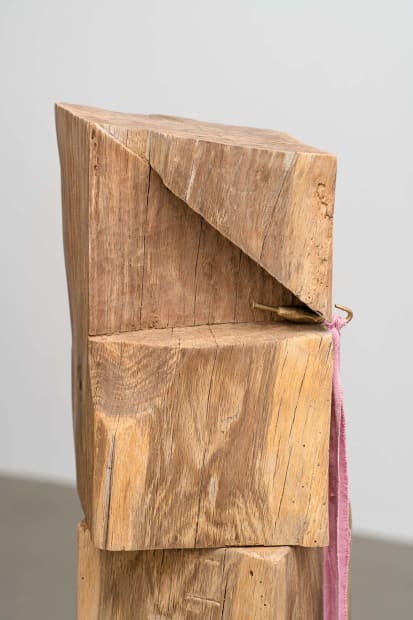
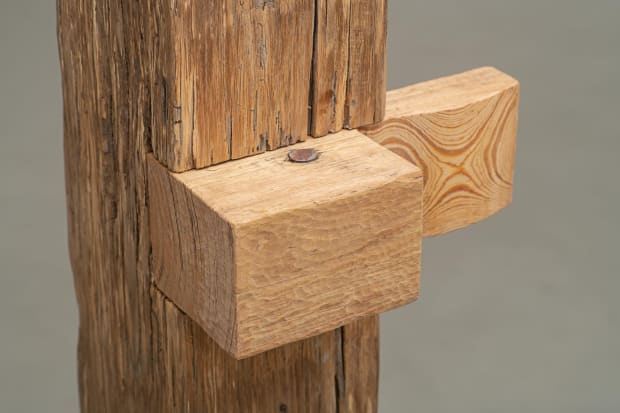
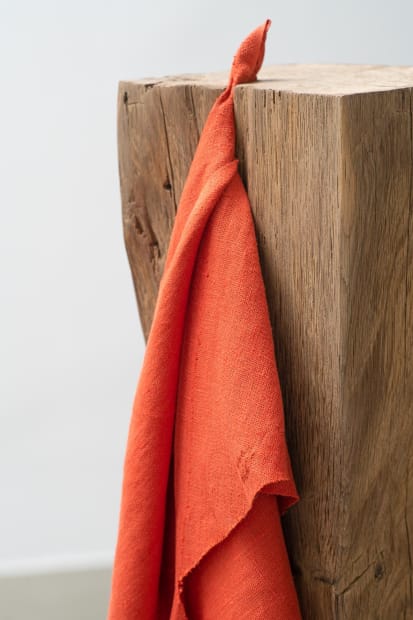
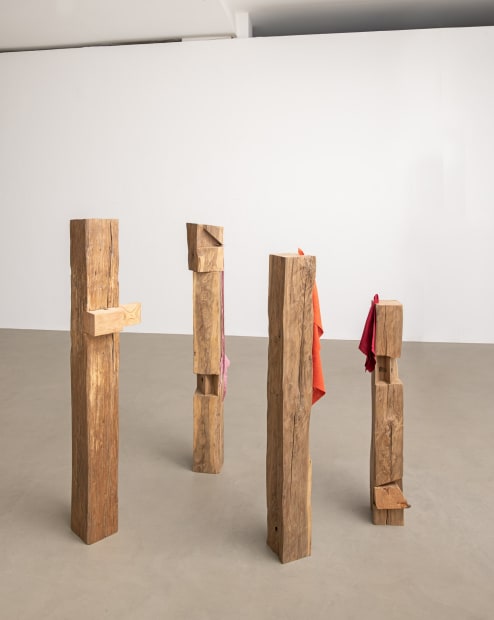
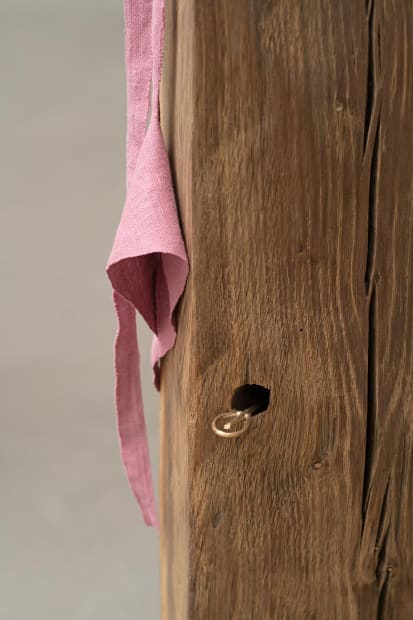
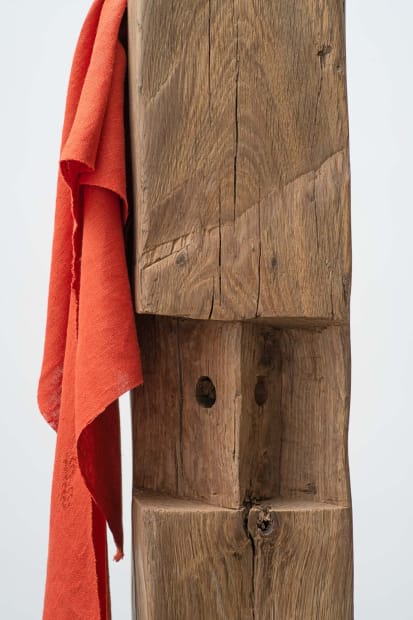
![Tonico Lemos Auad Arquitetura de sal, 2021 tecido feito à mão no tear, lã, linho [handwoven fabric, wool, linen] 126 x 150 x 2 cm 49 5/8 x 59 1/8 x 3/4 in](https://artlogic-res.cloudinary.com/w_600,c_limit,f_auto,fl_lossy,q_auto/artlogicstorage/galerialuisastrina/images/view/014dd322a11781b5b9ad3cb7463455baj/luisastrina-tonico-lemos-auad-arquitetura-de-sal-2021.jpg)
![Tonico Lemos Auad Carimbó, 2021 tecido feito à mão no tear, lã, linho [handwoven fabric, wool, linen] 82 x 100 x 2 cm 32 1/4 x 39 3/8 x 3/4 in](https://artlogic-res.cloudinary.com/w_600,c_limit,f_auto,fl_lossy,q_auto/artlogicstorage/galerialuisastrina/images/view/07a86bfd5234442e51f406e6dbf6ddcfj/luisastrina-tonico-lemos-auad-carimb-2021.jpg)
![Tonico Lemos Auad Cabeça de Búfalo / Cego, 2022 madeira de demolição entalhada [carved reclaimed lumber] 29 x 21 x 7 cm 11 3/8 x 8 1/4 x 2 3/4 in](https://artlogic-res.cloudinary.com/w_600,c_limit,f_auto,fl_lossy,q_auto/artlogicstorage/galerialuisastrina/images/view/19ed9f886dd5f3de95036ffd6fb2baa3j/luisastrina-tonico-lemos-auad-cabe-a-de-b-falo-cego-2022.jpg)
![Tonico Lemos Auad Cabeça de Búfalo / Dourado, 2022 madeira de demolição entalhada e bronze [carved reclaimed lumber and bronze] 29 x 21 x 7 cm 11 3/8 x 8 1/4 x 2 3/4 in](https://artlogic-res.cloudinary.com/w_600,c_limit,f_auto,fl_lossy,q_auto/artlogicstorage/galerialuisastrina/images/view/3da6691794f1bcc9d5542454e4c76c6bj/luisastrina-tonico-lemos-auad-cabe-a-de-b-falo-dourado-2022.jpg)
![Tonico Lemos Auad Cabeça de Búfalo / Iceberg, 2022 madeira de demolição entalhada e prata [carved reclaimed lumber and silver] 29 x 21 x 8 cm 11 3/8 x 8 1/4 x 3 1/8 in](https://artlogic-res.cloudinary.com/w_600,c_limit,f_auto,fl_lossy,q_auto/artlogicstorage/galerialuisastrina/images/view/765edab41422262e160397bef92f30ccj/luisastrina-tonico-lemos-auad-cabe-a-de-b-falo-iceberg-2022.jpg)
![Tonico Lemos Auad Cabeça de Búfalo / Soure, 2022 madeira de demolição entalhada, prata [carved reclaimed lumber, silver] 29 x 21 x 5 cm 11 3/8 x 8 1/4 x 2 in](https://artlogic-res.cloudinary.com/w_600,c_limit,f_auto,fl_lossy,q_auto/artlogicstorage/galerialuisastrina/images/view/a15941446a660a39934003b852a9d2c1j/luisastrina-tonico-lemos-auad-cabe-a-de-b-falo-soure-2022.jpg)
![Tonico Lemos Auad Cabeça de Búfalo / Marajó, 2022 madeira de demolição entalhada e prata [carved reclaimed lumber and silver] 49 x 21 x 6 cm 19 1/4 x 8 1/4 x 2 3/8 in](https://artlogic-res.cloudinary.com/w_600,c_limit,f_auto,fl_lossy,q_auto/artlogicstorage/galerialuisastrina/images/view/5b154298c5ee228561d1ffe0dc26a421j/luisastrina-tonico-lemos-auad-cabe-a-de-b-falo-maraj-2022.jpg)
![Tonico Lemos Auad Cabeça de Búfalo / Marajoara, 2022 madeira de demolição entalhada e prata [carved reclaimed lumber and silver] 29 x 21 x 5 cm 11 3/8 x 8 1/4 x 2 in](https://artlogic-res.cloudinary.com/w_600,c_limit,f_auto,fl_lossy,q_auto/artlogicstorage/galerialuisastrina/images/view/42e47acf4db35c625bce02d15b7f30fcj/luisastrina-tonico-lemos-auad-cabe-a-de-b-falo-marajoara-2022.jpg)

![Tonico Lemos Auad Cobra Preta, 2022 madeira de demolição entalhada, lã e linha de costura [carved reclaimed lumber, wool and sewing thread] 395 x 95 x 20 cm 155 1/2 x 37 3/8 x 7 7/8 in](https://artlogic-res.cloudinary.com/w_600,c_limit,f_auto,fl_lossy,q_auto/artlogicstorage/galerialuisastrina/images/view/da0eb65657b42fd6a34645e544e0f224j/luisastrina-tonico-lemos-auad-cobra-preta-2022.jpg)
![Tonico Lemos Auad Chão de pedras, 2022 madeira de demolição entalhada, lã e linha de costura [carved reclaimed lumber, wool and sewing thread] 395 x 30 x 126 cm 155 1/2 x 11 3/4 x 49 5/8 in](https://artlogic-res.cloudinary.com/w_600,c_limit,f_auto,fl_lossy,q_auto/artlogicstorage/galerialuisastrina/images/view/722d939ba49b2d6576495d7155df0761j/luisastrina-tonico-lemos-auad-ch-o-de-pedras-2022.jpg)
![Tonico Lemos Auad Pedra Azul, 2022 madeira de demolição entalhada, lã e linha de costura [carved reclaimed lumber, wool and sewing thread] 395 x 171 x 65 cm 155 1/2 x 67 3/8 x 25 5/8 in](https://artlogic-res.cloudinary.com/w_600,c_limit,f_auto,fl_lossy,q_auto/artlogicstorage/galerialuisastrina/images/view/21163bff69ed6778dd815d1946f9a37bj/luisastrina-tonico-lemos-auad-pedra-azul-2022.jpg)
![Tonico Lemos Auad Jibóia Dourada, 2022 bronze, lã e linha de costura [bronze, wool and sewing thread]](https://artlogic-res.cloudinary.com/w_600,c_limit,f_auto,fl_lossy,q_auto/artlogicstorage/galerialuisastrina/images/view/a66ea22b6ad4035c94acba4cfd3859a3j/luisastrina-tonico-lemos-auad-jib-ia-dourada-2022.jpg)
![Tonico Lemos Auad Cegueira / Vermelho e preto, 2022 madeira de demolição entalhada, linho [carved reclaimed lumber, linen] 63 x 46 cm 24 3/4 x 18 1/8 in](https://artlogic-res.cloudinary.com/w_600,c_limit,f_auto,fl_lossy,q_auto/artlogicstorage/galerialuisastrina/images/view/defc0c8729aa043b363542b83cd3ed3ej/luisastrina-tonico-lemos-auad-cegueira-vermelho-e-preto-2022.jpg)
![Tonico Lemos Auad Pirâmide, 2022 linho [linen] 64 x 63 x 3 cm 25 1/4 x 24 3/4 x 1 1/8 in](https://artlogic-res.cloudinary.com/w_600,c_limit,f_auto,fl_lossy,q_auto/artlogicstorage/galerialuisastrina/images/view/8a17033472339081676f98f1ca4627ecj/luisastrina-tonico-lemos-auad-pir-mide-2022.jpg)
![Tonico Lemos Auad Jibóia Arco-Íris, 2022 lã, papel, linho, algodão sobre tecido tramado [wool, paper, linen, cotton on woven fabric] 64 x 63 x 3 cm 25 1/4 x 24 3/4 x 1 1/8 in](https://artlogic-res.cloudinary.com/w_600,c_limit,f_auto,fl_lossy,q_auto/artlogicstorage/galerialuisastrina/images/view/e58d6ec0aa0ff3dc8234570e00871aaej/luisastrina-tonico-lemos-auad-jib-ia-arco-ris-2022.jpg)
![Tonico Lemos Auad Desenhos e colar na areia [Necklace for Iemanjá], 2022 algodão e papel sobre tecido tramado [cotton and paper on woven fabric] 64 x 63 x 3 cm 25 1/4 x 24 3/4 x 1 1/8 in](https://artlogic-res.cloudinary.com/w_600,c_limit,f_auto,fl_lossy,q_auto/artlogicstorage/galerialuisastrina/images/view/4b16a25964c46bedc4561002d149c546j/luisastrina-tonico-lemos-auad-desenhos-e-colar-na-areia-necklace-for-iemanj-2022.jpg)
![Tonico Lemos Auad Hippocampus, 2021 lã, papel, linho, algodão [wool, paper, linen, cotton] 65 x 64 x 3 cm 25 5/8 x 25 1/4 x 1 1/8 in](https://artlogic-res.cloudinary.com/w_600,c_limit,f_auto,fl_lossy,q_auto/artlogicstorage/galerialuisastrina/images/view/9a04c914be1907dbf59681e94bf745bdj/luisastrina-tonico-lemos-auad-hippocampus-2021.jpg)
![Tonico Lemos Auad Outubro, 2021 lã, papel, linho, algodão [wool, paper, linen, cotton] 64 x 63 x 3 cm 25 1/4 x 24 3/4 x 1 1/8 in](https://artlogic-res.cloudinary.com/w_600,c_limit,f_auto,fl_lossy,q_auto/artlogicstorage/galerialuisastrina/images/view/e61bc022daabbf9c9553be878b2b42fdj/luisastrina-tonico-lemos-auad-outubro-2021.jpg)
![Tonico Lemos Auad Noturno, 2021 lã, papel, linho, algodão [wool, paper, linen, cotton] 64 x 63 x 3 cm 25 1/4 x 24 3/4 x 1 1/8 in](https://artlogic-res.cloudinary.com/w_600,c_limit,f_auto,fl_lossy,q_auto/artlogicstorage/galerialuisastrina/images/view/5a1e4a213a15b8bb98f72f63c6dcf540j/luisastrina-tonico-lemos-auad-noturno-2021.jpg)
![Tonico Lemos Auad Bandeirinhas, 2022 algodão, lã e seda sobre linho [cotton, wool and silk on linen] 65 x 64 x 3 cm 25 5/8 x 25 1/4 x 1 1/8 in](https://artlogic-res.cloudinary.com/w_600,c_limit,f_auto,fl_lossy,q_auto/artlogicstorage/galerialuisastrina/images/view/03b680707deba89ca75f2dcf92b1ea9aj/luisastrina-tonico-lemos-auad-bandeirinhas-2022.jpg)
![Tonico Lemos Auad Orquestra [Orchestra], 2022 algodão, lã e seda sobre linho [cotton, wool and silk on linen] 64 x 65 x 3 cm 25 1/4 x 25 5/8 x 1 1/8 in](https://artlogic-res.cloudinary.com/w_600,c_limit,f_auto,fl_lossy,q_auto/artlogicstorage/galerialuisastrina/images/view/29356a7eba1d4782e665d80a8aa5e010j/luisastrina-tonico-lemos-auad-orquestra-orchestra-2022.jpg)
![Tonico Lemos Auad Sem título, 2021 lã, papel, linho, algodão [wool, paper, linen, cotton] 31 x 26 x 3 cm 12 1/4 x 10 1/4 x 1 1/8 in](https://artlogic-res.cloudinary.com/w_600,c_limit,f_auto,fl_lossy,q_auto/artlogicstorage/galerialuisastrina/images/view/a389002c4a00423b6a51e9bbe92aec26j/luisastrina-tonico-lemos-auad-sem-t-tulo-2021.jpg)

